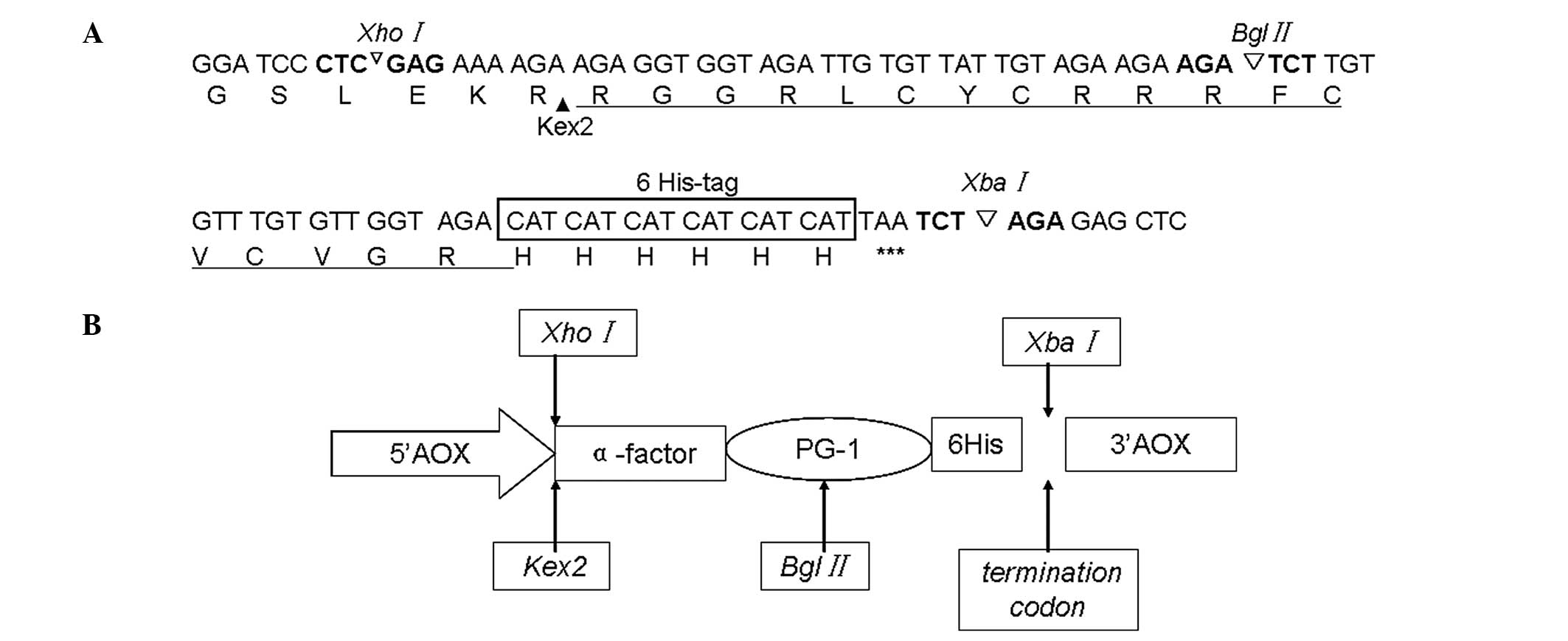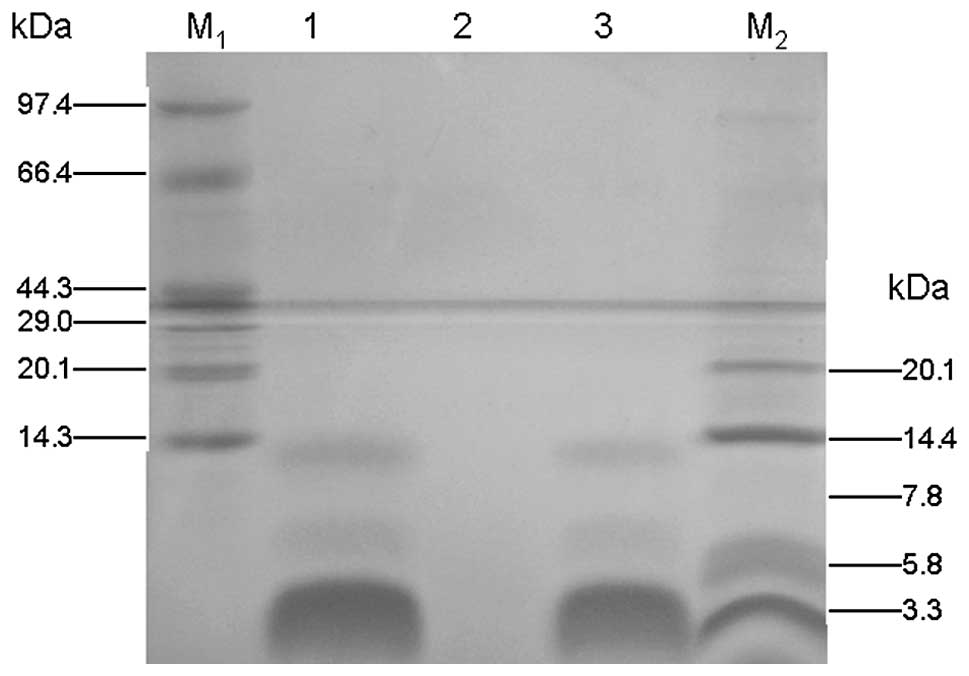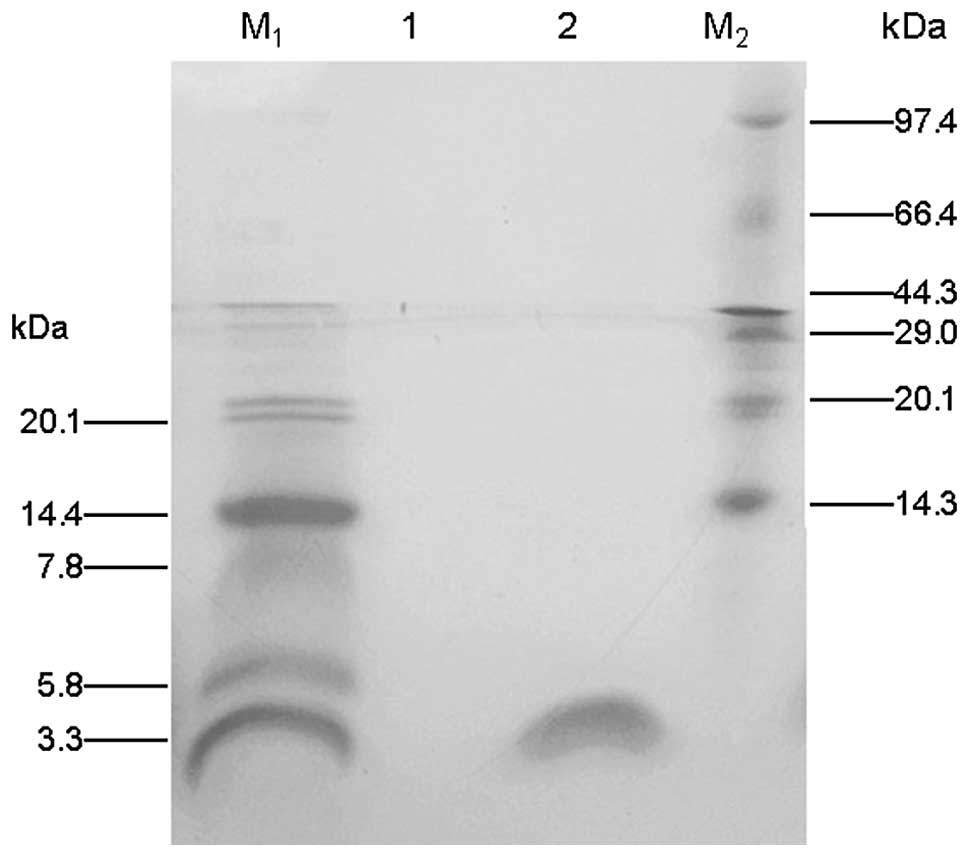|
1
|
Bolintineanu DS and Kaznessis YN:
Computational studies of protegrin antimicrobial peptides: a
review. Peptides. 32:188–201. 2011. View Article : Google Scholar :
|
|
2
|
Wang L, Lai C, Wu Q, Liu J, Zhou M, Ren Z,
Sun D, Chen S and Xu A: Production and characterization of a novel
antimicrobial peptide HKABF by Pichia pastoris. Process Biochem.
43:1124–1131. 2008. View Article : Google Scholar
|
|
3
|
Chen H, Xu Z, Peng L, Fang X, Yin X, Xu N
and Cen P: Recent advances in the research and development of human
defensins. Peptides. 27:931–940. 2006. View Article : Google Scholar
|
|
4
|
Rui H, Lee J and Im W: Comparative
molecular dynamics simulation studies of protegrin-1 monomer and
dimer in two different lipid bilayers. Biophys J. 97:787–795. 2009.
View Article : Google Scholar : PubMed/NCBI
|
|
5
|
Panchal RG, Smart ML, Bowser DN, Williams
DA and Petrou S: Pore-forming proteins and their application in
biotechnology. Curr Pharm Biotechnol. 3:99–115. 2002. View Article : Google Scholar : PubMed/NCBI
|
|
6
|
Kokryakov VN, Harwig SS, Panyutich EA,
Shevchenko AA, Aleshina GM, Shamova OV, et al: Protegrins:
leukocyte antimicrobial peptides that combine features of
corticostatic defensins and tachyplesins. FEBS Lett. 327:231–236.
1993. View Article : Google Scholar : PubMed/NCBI
|
|
7
|
Qu XD, Harwig SS, Shafer WM and Lehrer RI:
Protegrin structure and activity against Neisseria gonorrhoeae.
Infect Immun. 65:636–639. 1997.PubMed/NCBI
|
|
8
|
Fan F, Wu Y and Liu J: Expression and
purification of two different antimicrobial peptides, PR-39 and
Protegrin-1 in Escherichia coli. Protein Expr Purif. 73:147–151.
2010. View Article : Google Scholar : PubMed/NCBI
|
|
9
|
Feng X, Liu C, Guo J, Song X, Li J, Xu W
and Li Z: Recombinant expression, purification, and antimicrobial
activity of a novel hybrid antimicrobial peptide LFT33. Appl
Microbiol Biotechnol. 95:1191–1198. 2012. View Article : Google Scholar
|
|
10
|
Moers AP, Wolbert EJ, de Wolf FA and
Werten MW: Secreted production of self-assembling peptides in
Pichia pastoris by fusion to an artificial highly hydrophilic
protein. J Biotechnol. 146:66–73. 2010. View Article : Google Scholar : PubMed/NCBI
|
|
11
|
Jin F, Xu X, Zhang W and Gu D: Expression
and characterization of a housefly cecropin gene in the
methylotrophic yeast, Pichia pastoris. Protein Expr Purif.
49:39–46. 2006. View Article : Google Scholar : PubMed/NCBI
|
|
12
|
Peng H, Liu HP, Chen B, Hao H and Wang KJ:
Optimized production of scygonadin in Pichia pastoris and analysis
of its antimicrobial and antiviral activities. Protein Expr Purif.
82:37–44. 2012. View Article : Google Scholar
|
|
13
|
Zhang J, Yang Y, Teng D, Tian Z, Wang S
and Wang J: Expression of plectasin in Pichia pastoris and its
characterization as a new antimicrobial peptide against
Staphyloccocus and Streptococcus. Protein Expr Purif. 78:189–196.
2011. View Article : Google Scholar : PubMed/NCBI
|
|
14
|
Niu M, Li X, Wei J, Cao R, Zhou B and Chen
P: The molecular design of a recombinant antimicrobial peptide CP
and its in vitro activity. Protein Expr Purif. 57:95–100. 2008.
View Article : Google Scholar
|
|
15
|
Lee JH, Kim JH, Hwang SW, Lee WJ, Yoon HK,
Lee HS and Hong SS: High-level expression of antimicrobial peptide
mediated by a fusion partner reinforcing formation of inclusion
bodies. Biochem Biophys Res Commun. 277:575–580. 2000. View Article : Google Scholar : PubMed/NCBI
|
|
16
|
Schägger H and von Jagow G: Tricine-sodium
dodecyl sulfate-polyacrylamide gel electrophoresis for the
separation of proteins in the range from 1 to 100 kDa. Anal
Biochem. 166:368–379. 1987. View Article : Google Scholar : PubMed/NCBI
|
|
17
|
Lehrer RI, Rosenman M, Harwig SS, Jackson
R and Eisenhauer P: Ultrasensitive assays for endogenous
antimicrobial polypeptides. J Immunol Methods. 137:167–173. 1991.
View Article : Google Scholar : PubMed/NCBI
|
|
18
|
Selvakumaran M, Pisarcik DA, Bao R, Yeung
AT and Hamilton TC: Enhanced cisplatin cytotoxicity by disturbing
the nucleotide excision repair pathway in ovarian cancer cell
lines. Cancer Res. 63:1311–1316. 2003.PubMed/NCBI
|
|
19
|
Capone R, Mustata M, Jang H, Arce FT,
Nussinov R and Lal R: Antimicrobial protegrin-1 forms ion channels:
molecular dynamic simulation, atomic force microscopy, and
electrical conductance studies. Biophys J. 98:2644–2652. 2010.
View Article : Google Scholar : PubMed/NCBI
|
|
20
|
Langham AA, Khandelia H, Schuster B,
Waring AJ, Lehrer RI and Kaznessis YN: Correlation between
simulated physicochemical properties and hemolycity of
protegrin-like antimicrobial peptides: predicting experimental
toxicity. Peptides. 29:1085–1093. 2008. View Article : Google Scholar : PubMed/NCBI
|
|
21
|
Jang H, Ma B, Lal R and Nussinov R: Models
of toxic beta-sheet channels of protegrin-1 suggest a common
subunit organization motif shared with toxic alzheimer beta-amyloid
ion channels. Biophys J. 95:4631–4642. 2008. View Article : Google Scholar : PubMed/NCBI
|
|
22
|
Bolintineanu D, Hazrati E, Davis HT,
Lehrer RI and Kaznessis YN: Antimicrobial mechanism of pore-forming
protegrin peptides: 100 pores to kill E. coli. Peptides. 31:1–8.
2010. View Article : Google Scholar :
|
|
23
|
Kant P, Liu WZ and Pauls KP: PDC1, a corn
defensin peptide expressed in Escherichia coli and Pichia pastoris
inhibits growth of Fusarium graminearum. Peptides. 30:1593–1599.
2009. View Article : Google Scholar : PubMed/NCBI
|
|
24
|
Li Z, Moy A, Sohal K, Dam C, Kuo P,
Whittaker J, Whittaker M, Düzgünes N, Konopka K, Franz AH,
Lin-Cereghino J and Lin-Cereghino GP: Expression and
characterization of recombinant human secretory leukocyte protease
inhibitor (SLPI) protein from Pichia pastoris. Protein Expr Purif.
67:175–181. 2009. View Article : Google Scholar : PubMed/NCBI
|
|
25
|
Pokoj S, Lauer I, Fötisch K, Himly M, Mari
A, Enrique E, del Miguel-Moncin MM, Lidholm J, Vieths S and
Scheurer S: Pichia pastoris is superior to E. coli for the
production of recombinant allergenic non-specific lipid-transfer
proteins. Protein Expr Purif. 69:68–75. 2010. View Article : Google Scholar
|













